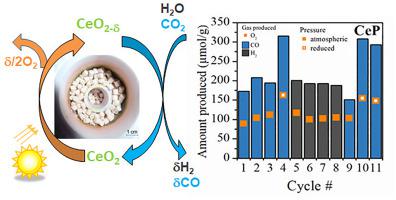Sustainable Materials and Technologies ( IF 8.6 ) Pub Date : 2021-07-31 , DOI: 10.1016/j.susmat.2021.e00328 Stéphane Abanades 1 , Anita Haeussler 1

|
The thermochemical redox activity and performance of commercial-grade fibrous ceria pellets were determined including fuel production rates and yields from H2O and CO2 dissociation. Two solar reactors integrating the ceria pellets undergoing two-step thermochemical cycling (with temperature-swing between alternating redox steps) were experimentally tested. They consisted of packed-bed tubular and cavity-type solar reactors with direct or indirect heating of the reacting materials. The obtained fuel production rates compared favorably with the performance of other previously considered microstructured ceria materials such as templated foams, sintered felts, bioinspired or ordered macroporous morphologies. H2 production rates reached 2.3 mL.g−1.min−1 (with H2/O2 ratios approaching 2) in the indirectly-heated tubular reactor after reduction at 1400 °C and oxidation upon free cooling below 950 °C in steam atmosphere (57% molar content). The highest fuel production rate (~9.5 mL.g−1.min−1) and peak solar-to-fuel energy efficiency (~9.4%) were reached in the directly-irradiated cavity-type reactor (with a reduction step at 1400 °C under reduced pressure, and an oxidation step in pure CO2 below 950 °C). The reduction extent was favored at low pO2 (δ up to 0.056) and the fuel yields were thus improved notably (up to 315 μmol/g) by decreasing the total pressure below 0.1 bar during the reduction step. The fuel production rate increased when the oxidation temperature decreased (because the reaction was thermodynamically more favorable). An increase in CO2 partial pressure further promoted the oxidation kinetics (and decreased the pCO/pCO2 ratio, thus shifting the thermodynamic equilibrium toward CO product). The fibrous ceria structures exhibited stable morphologies with high fuel production performance similar to less scalable porous structures, thus offering the potential for versatile applications in packed-bed solar reactors.
中文翻译:

使用纤维状氧化铈颗粒在填充床太阳能反应器中产生 H2 和减少 CO2 的两步热化学循环
确定了商业级纤维状氧化铈颗粒的热化学氧化还原活性和性能,包括燃料生产率和 H 2 O 和 CO 2离解的产率。实验测试了两个太阳能反应器,这些反应器集成了经过两步热化学循环(交替氧化还原步骤之间的温度摆动)的二氧化铈颗粒。它们由填充床管式和腔式太阳能反应器组成,可直接或间接加热反应材料。获得的燃料生产率与之前考虑的其他微结构氧化铈材料的性能相比具有优势,例如模板泡沫、烧结毡、仿生或有序大孔形态。H 2生产率达到2.3 mL.g -1.min -1 (H 2 /O 2比接近2)在1400°C还原和在蒸汽气氛(57%摩尔含量)中自由冷却至950°C以下氧化后在间接加热的管式反应器中。最高燃料生产速率(〜9.5 mL.g -1 .min -1)和峰值太阳能到燃料能源效率(〜9.4%)在直接照射的腔式反应器中达到(具有在1400还原步骤°C 减压下,以及在低于 950 °C 的纯 CO 2中的氧化步骤)。低p O2有利于减少程度(δ 高达 0.056),因此通过在还原步骤中将总压力降低到 0.1 bar 以下,燃料产率显着提高(高达 315 μmol/g)。当氧化温度降低时,燃料产率增加(因为反应在热力学上更有利)。CO 2分压的增加进一步促进了氧化动力学(并降低了p CO / p CO2比率,从而使热力学平衡向 CO 产物移动)。纤维状氧化铈结构表现出稳定的形态,具有类似于可扩展性较差的多孔结构的高燃料生产性能,从而为填充床太阳能反应堆的多功能应用提供了潜力。











































 京公网安备 11010802027423号
京公网安备 11010802027423号